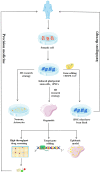Human Brain Organoids as an In Vitro Model System of Viral Infectious Diseases
- PMID: 35087520
- PMCID: PMC8786735
- DOI: 10.3389/fimmu.2021.792316
Human Brain Organoids as an In Vitro Model System of Viral Infectious Diseases
Abstract
Brain organoids, or brainoids, have shown great promise in the study of central nervous system (CNS) infection. Modeling Zika virus (ZIKV) infection in brain organoids may help elucidate the relationship between ZIKV infection and microcephaly. Brain organoids have been used to study the pathogenesis of SARS-CoV-2, human immunodeficiency virus (HIV), HSV-1, and other viral infections of the CNS. In this review, we summarize the advances in the development of viral infection models in brain organoids and their potential application for exploring mechanisms of viral infections of the CNS and in new drug development. The existing limitations are further discussed and the prospects for the development and application of brain organs are prospected.
Keywords: brain organoid; brainoid; infection; model system; pathogenesis; prion; virus.
Copyright © 2022 Su, Yue, Kong, Xu, Zhang, Cao, Fan, Liu, Chen, Liu and Bao.
Conflict of interest statement
The authors declare that the research was conducted in the absence of any commercial or financial relationships that could be construed as a potential conflict of interest.
Figures


References
Publication types
MeSH terms
LinkOut - more resources
Full Text Sources
Miscellaneous

